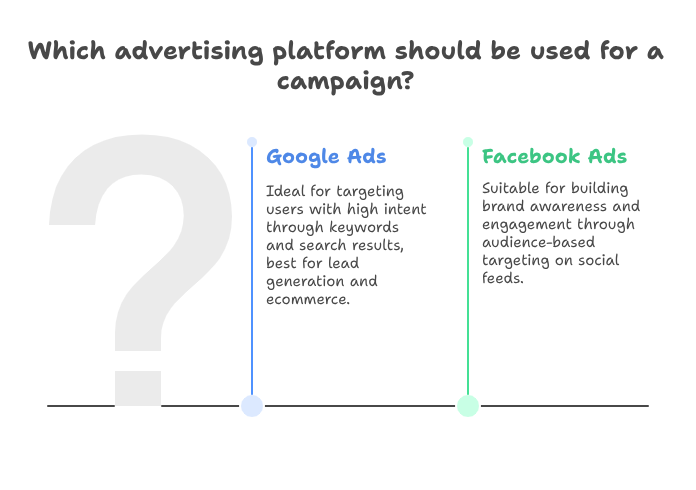In today’s digital-first world, online advertising is essential for business growth. Two of the most dominant players—Google Ads and Facebook Ads (Meta Ads)—offer powerful tools to reach your ideal customers. But when it comes to Google Ads vs Facebook Ads, which delivers better results for your business in 2025?
In this comprehensive guide, we’ll break down the differences between paid social and paid search, explore ad formats, placements, targeting options, and help you decide which platform aligns best with your goals.
What is Google Ads?
Google Ads is a keyword-based advertising platform that displays your ads on Google Search, YouTube, apps, and partner websites. It primarily focuses on search intent—your ads appear when users actively search for specific products, services, or solutions.
Google Ads Placement Options:
- Google Search (SERPs)
- YouTube Ads
- Google Display Network (GDN)
- Mobile app ads
- Gmail sponsored promotions
These placements allow businesses to reach users across the Google ecosystem, from watching videos to browsing the web.
What is Facebook Ads (Meta Ads)?
Facebook Ads (now part of Meta Ads) is a paid social media advertising platform. It allows brands to reach users based on demographics, interests, behaviors, and online activity—even if users aren’t actively searching for anything.
Facebook Ads Placement Options (2025):
- Facebook Feed, Stories & Reels
- Instagram Feed, Reels, and Stories
- Messenger Ads
- Meta Audience Network (third-party apps & sites)
- Facebook Marketplace
Meta’s ad placements are optimized for discovery, engagement, and brand building across its entire network.
Key Differences: Google Ads vs Facebook Ads

| Feature | Google Ads | Facebook Ads (Meta) |
|---|---|---|
| Targeting Approach | Keyword & intent-based | Audience & behavior-based |
| User Intent | High (searching for answers) | Passive (browsing content) |
| Ad Placement | SERP, YouTube, GDN, apps | Social feeds, Messenger, Reels |
| Best For | Leads, search traffic, ecommerce | Brand awareness, engagement, remarketing |
Similarities Between Google and Facebook Ads
Despite their differences, both platforms offer:
- Massive Reach – Billions of active users globally
- AI Optimization Tools – Smart bidding and machine learning
- Advanced Tracking – Pixels, tags, and attribution analytics
- Flexible Budgets – Set daily or campaign-level limits
- Custom Audiences – Target warm leads and retarget visitors
These features make Google Ads vs Facebook Ads in 2025 effective tools for small businesses and large enterprises alike.
Google Ads Formats in 2025
Google provides various ad formats designed for every stage of the buyer journey:
- Search Ads – Appear on Google Search results
- Display Ads – Banner/image ads across websites & apps
- Shopping Ads – Product listings with real-time info
- YouTube Video Ads – Skippable and non-skippable formats
- Bumper Ads – 6-second non-skippable video ads
- Performance Max – Unified AI-powered campaigns
- Smart Campaigns – Automated ads for local/small businesses
- Demand Gen Ads – New visual-first ad type for discovery
Facebook (Meta) Ads Formats in 2025
Meta Ads are mobile-first and designed for high engagement:
- Image Ads – Simple and effective for direct messaging
- Video Ads – Perfect for storytelling and product demos
- Carousel Ads – Multiple images/videos in one ad unit
- Collection Ads – Shop-style formats for ecommerce
- Reels & Story Ads – Full-screen, vertical mobile ads
- Messenger Ads – Direct messaging-based CTAs
- Lead Ads – In-platform lead generation forms
inal Verdict: Which Platform Should You Choose?
The choice between Google Ads vs Facebook Ads in 2025 depends on your business goals, target audience, and sales funnel stage.
Use Google Ads if you:
- Want to capture high-intent buyers
- Are focused on ecommerce, local SEO, or lead generation
- Need visibility in search results and on YouTube
Use Facebook Ads (Meta) if you:
- Aim to build brand awareness or engagement
- Want to retarget website visitors and grow a warm audience
- Thrive with visual content and storytelling
Pro Tip for 2025 Advertising Success
Start small, test multiple ad formats and placements, and analyze your data regularly. Run A/B tests, optimize based on conversions, and scale winning campaigns.
✔️ Test. Optimize. Scale.
That’s the formula for paid media success in 2025.
2. FAQ Schema with Keyword-Rich Questions
Q1: Which is better for business in 2025: Google Ads vs Facebook Ads?
A: It depends on your goals. Google Ads is best for capturing high-intent search traffic, while Facebook Ads is ideal for brand awareness and audience engagement.
Q2: What are the key differences between Google Ads vs Facebook Ads?
A: Google Ads relies on keyword targeting and search intent, while Facebook Ads uses behavior, interests, and demographics to reach users on social platforms.
Q3: What are the latest ad formats in Google Ads for 2025?
A: New formats include Performance Max campaigns, Demand Gen ads, and enhanced shopping experiences across the Google Display Network.
Q4: How do Facebook Ads placements work in 2025?
A: Facebook Ads can appear in Feeds, Stories, Reels, Messenger, Instagram, and across Meta Audience Network (external apps and sites).
Q5: Can I use both Google Ads vs Facebook Ads together?
A: Yes! Using both platforms allows a full-funnel strategy—Facebook for discovery and engagement, Google for conversions and intent-based traffic.

